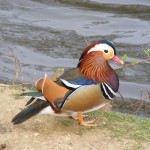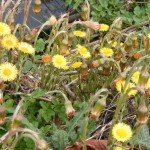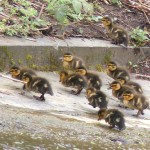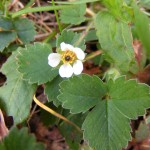Renee Grayer led twenty members on a gentle, peaceful stroll through the Wilderness and around Whiteknights Lake and most of the party continued into the Harris Garden. The weather was fine and warm, birds were singing, including chiffchaffs and blackcaps. A mother mallard anxiously protected her 15 tiny ducklings on the lake and a pair of Egyptian geese guarded their four rather older goslings. Mandarin drakes posed, great crested grebes dived and male mallards were on the lookout for willing females. Unusually, there were no mute swans on the lake.
Both Whiteknights Park and the Harris Garden are examples of areas greatly influenced by human activity but retaining many of the plant species that would have been there well before the landscape gardeners moved in. Woodland species – celandines, wood anemones, primroses, a colony of goldilocks, were noted under native and exotic tree species and garden escapes such as Hemerocallis (Day Lily). Snakes head fritillaries, almost certainly planted, thrived and coltsfoot was abundant on the banks of the lake. There is always disturbed land in a university campus: here there were Veronica filiformis and Montia perfoliata. Members were able to compare the two somewhat similar exotic tree species Swamp Cypress (Taxodium distichum) and Dawn Redwood (Metasequoia glyptostroboides).
There was evidence of major activity in the Harris Garden as a result of a change in management but the grassland areas retained their rich diversity of species. The Wollemi Pine planted recently clearly is able to thrive in cold winters.
Unexpectedly, very few butterflies were seen but there were several bee flies (Bombylius major) feeding on flowers in the wilderness.
Report by Chris Bucke
Pictures by Rob Stallard
RDNHS trip to Whiteknights, the Wilderness and the Harris Garden, 04-04-2011
Plant species:
| Anemone nemorosa | Wood Anemone |
| Anthriscus sylvestris | Cow Parsley |
| Conopodium majus | Pignut (not yet in flower) |
| Fritillaria meleagris | Fritillary (planted) |
| Impatiens parviflora | Small Balsam (seedlings) |
| Iris foetidissima | Stinking Iris (not yet in flower) |
| Iris pseudacorus | Yellow Iris (not yet in flower) |
| Luzula campestris | Field Wood-rush |
| Lysichiton americanus | Skunk Cabbage (naturalised) |
| Oenanthe crocata | Hemlock Water-dropwort (leaves) |
| Pentaglottis sempervirens | Green Alkanet |
| Petasites hybridus | Butterbur |
| Potentilla sterilis | Barren Strawberry |
| Primula veris | Cowslip (planted) |
| Primula vulgaris | Primrose |
| Prunus padus | Bird Cherry |
| Prunus spinosa | Blackthorn |
| Ranunculus auricomus | Goldilocks Buttercup |
| Ranunculus ficaria | Lesser Celandine |
| Rubus idaeus | Raspberry |
| Tussilago farfara | Coltsfoot |
| Veronica filiformis | Slender Speedwell |
| Veronica hederifolia | Ivy-leaved Speedwell |
| Viola riviniana | Common Dog-violet |
Bird species:
Canada goose
Chiffchaff
Coot
Egyptian Goose (parents with four young)
Goldfinch
Great Crested Grebe
Jay
Longtailed Tit
Mallard (mother with 15 ducklings)
Mandarin Duck
Moorhen
Nuthatch
Red Kite
Song Thrush
Wren
Insects:
Bombus lapidarius (a bumble bee species)
Bombylius major (Bee fly)
List by Renee Grayer




